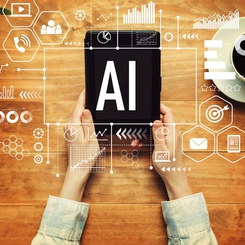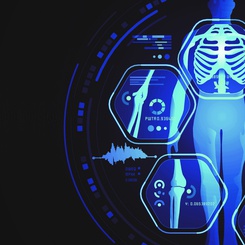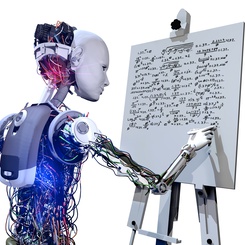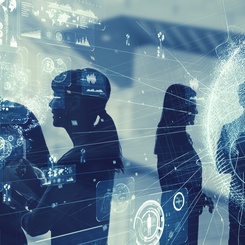With ESSEC Knowledge Editor-in-chief
We’re all thinking about it: how is AI going to impact our jobs? Julien Malaurent, Professor of Information Systems, and co-director of the ESSEC Metalab, conducted a study with the OECD to explore the impact of AI on work in eight OECD member countries, looking at how AI will impact work, how employees adapt, and new challenges that arise.
Dr. Malaurent led the France component of the study. The study examined companies in the manufacturing, finance, and insurance sectors in the United States, Canada, the United Kingdom, Ireland, Germany, and Austria, collecting responses from over 2000 employers and 5300 employees between mid-January and mid-February 2022. They complemented this quantitative data with qualitative data from over 100 companies across the seven countries and in Japan.
Who is impacted by the use of AI?
Study participants held a wide range of jobs, with different levels of exposure to AI at work. That being said, the researchers did identify some demographic trends. Compared to non-users, AI users were more likely to be younger, male, and more educated. The researchers found that older workers may have a harder adjustment process and appear less enthusiastic about it. This suggests that AI has the potential to impact everyone, even if they aren’t using these technologies in their day-to-day life.
How will AI impact our jobs?
Three trends emerged from this data:
If AI is used correctly, it can boost productivity and job quality.
There’s reason to be hopeful: the majority of participants found that AI can boost productivity and job quality. Around 80% of participants shared that using AI had boosted their performance at work, with only 8% reporting a decline they attributed to AI. In fact, most users found that it boosted their decision-making. Employers see this potential for improved performance as one of the key incentives for AI usage, alongside reducing staff-related costs. When companies consulted their employees about AI adoption, they tended to experience more positive outcomes in terms of employee performance and working conditions. This suggests that it’s important to include employees in the conversation moving forward.
In what may just be its biggest selling point, workers also identified possible boosts to job quality. AI has the potential to help with the not-so-fun parts of the job and reduce time spent on tedious tasks, boost engagement and improve physical safety. At the moment, employment rates are stable, though hiring may have slowed down. Dr. Malaurent notes that “Even if an organization’s AI use is very sophisticated, there’s a shared belief that some tasks will always be best done by humans, like those involving empathy, social interaction, and decision-making related to human resources”.
Using AI requires new skills, and companies need to rise to the occasion.
To make the most of AI, companies should ensure that their employees are equipped with the right skillset, for example analytical, “human” skills (like creativity, communication, and critical thinking), and specialized AI skills.
Many companies surveyed are already responding and offering or funding specialized training, focusing on upskilling current employees. Employees who received training also tended to report that AI had a positive impact on their working conditions.
While most workers felt enthusiastic about the opportunity to learn more, some employees are also expressing that they feel increased pressure at work, in part because they feel increasingly surveilled at work. In addition, employees who had participated in training were more likely to express concerns about their job stability, perhaps because they see what AI can do or because they worry about having the required skills. Taken together, this suggests that it benefits both companies and employees when companies provide training to use these new technologies, although it does not assuage all fears.
Employers view a skills mismatch and high costs as the main barriers to widespread AI implementation.
Even if companies are starting to respond to the need for AI training, they also express that the current skills mismatch is a barrier to widespread AI implementation. The cost is also a barrier to use. Offering and funding training programs can be expensive, as can the tools themselves.
Will the robots take our jobs? Not so fast
While employers did identify reducing staff costs as a key motivation for using AI, they also reported that their employment levels have not changed due to AI. However, among companies using AI, there were more with decreased staff numbers than with increased staff numbers, a clue that AI might be automating more jobs than it’s creating right now. While around half of employees reported that they weren’t concerned about their job’s future, AI users were more likely to report concern, and many workers did indicate that they expected salaries in their field to decrease due to AI over the next decade.
All together, the outlook for AI’s impact on the labor market gives reason to be positive. Employees in companies that already use AI report its boost to their productivity and working conditions, and are on board with taking part in training to learn more. We’re not yet seeing mass redundancies in favor of AI automation, and companies are choosing to upskill and retrain their current employees to adapt to new ways of working. That said, this can be costly and form a barrier to widespread adoption of AI technologies. Employees need to be included in the conversation about AI usage at work to promote decent work moving forward.
Further reading
Milanez, A. (2023), "The impact of AI on the workplace: Evidence from OECD case studies of AI implementation", OECD Social, Employment and Migration Working Papers, No. 289, OECD Publishing, Paris, https://doi.org/10.1787/2247ce58-en.









